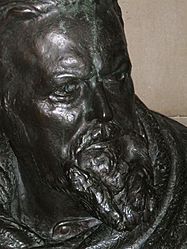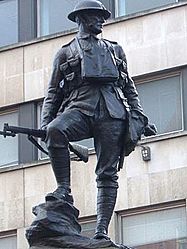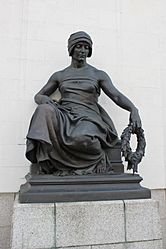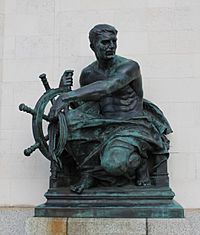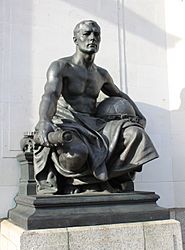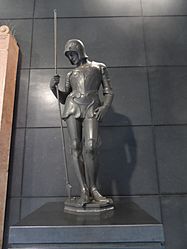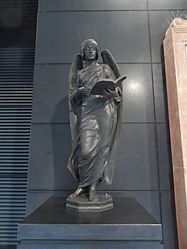Albert Toft facts for kids
Quick facts for kids
Albert Toft
|
|
|---|---|
| Born | 3 June 1862 Handsworth, Staffordshire, England
|
| Died | 18 December 1949 (aged 87) |
| Nationality | English |
| Alma mater | South Kensington Schools |
| Occupation | sculptor |
Albert Toft (born June 3, 1862 – died December 18, 1949) was a famous English sculptor. He was known for creating many public statues, especially of important people like kings, queens, and military figures.
Albert Toft's career was very busy, especially during big events like Queen Victoria's Diamond Jubilee in 1897, the Second Boer War (1899-1902), and World War I (1914-1918). These events led to many requests for his sculptures. Experts describe Toft as a key artist in the "New Sculpture" movement. He called his own work "Idealist," meaning he aimed to show perfect forms. But he also said that to be an idealist, you first had to be a "realist," meaning you needed to be good at showing things as they truly are.
Albert's father was a skilled artist who made models for pottery. His brother, Joseph Alfonso Toft, was also an artist who painted landscapes.
Contents
Biography
Albert Toft was born in Handsworth, which was part of Staffordshire back then. Today, Handsworth is a suburb of Birmingham. His parents were Charles Toft and Rosanna Reeves. His father, Charles, was a top model maker at famous pottery companies like Mintons and Wedgwood. He also taught art at the Birmingham School of Art.
Albert learned his skills at Wedgwood, just like his father. He also went to art schools in Hanley, Staffordshire and Newcastle upon Tyne. In 1881, he won a special scholarship to study sculpture at the South Kensington Schools. There, he learned from Professor Édouard Lantéri and won silver medals for his excellent work.
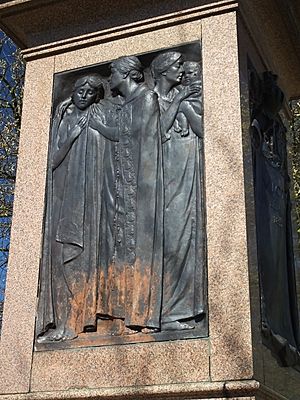
From 1885 onwards, Albert Toft showed his sculptures at the Royal Academy of Arts. Some of his most famous works included Fate-Led (1890), Spring (1897), and The Spirit of Contemplation (1901). In 1915, his sculpture The Bather was bought by the Royal Academy. He also made a bust (a sculpture of someone's head and shoulders) of a famous politician named William Ewart Gladstone in 1888, which was highly praised. In 1900, Toft won a bronze medal at a big art show in Paris.
He created important statues of Queen Victoria for cities like Leamington Spa, Nottingham, and South Shields. He also made statues of Edward VII for Birmingham and Warwick. Albert Toft even designed the special medal for the coronation of King George V and Queen Mary in 1911. In 1911, he published a book called Modelling and Sculpture, which was very popular and reprinted many years later.
Albert Toft created many war memorials. He started with the South African War Memorial, Cardiff in 1910. After World War I, he made many more, including the Royal Fusiliers War Memorial in London (1922) and four statues for the Hall of Memory, Birmingham (1923–24).
In 1891, Toft became a member of the Art Workers Guild, a group for artists and craftspeople. In 1938, he was made a fellow of the Royal Society of British Sculptors, which is a great honor for sculptors.
He passed away in Worthing in 1949.
Public monuments and memorials
Albert Toft created many public statues and memorials that you can still see today. These sculptures often honored important people or remembered significant events like wars. He used materials like bronze, marble, and granite to make his lasting artworks.
Some of his notable public works include:
- A statue of Henry Richard in Tregaron, Wales, made of bronze and granite (1893).
- Statues of Queen Victoria in places like Royal Leamington Spa (1901) and Nottingham (1905).
- A statue of Charles Mark Palmer in Jarrow, a shipbuilder and politician (1903).
- Several memorials for the Second Boer War, including ones in Ipswich (1906) and Cannon Hill Park, Birmingham (1906).
- The South African War Memorial, Cardiff (1909), featuring sculptures on a large stone base.
- The King Edward VII Memorial in Centenary Square, Birmingham (1913).
- A statue of Queen Victoria in South Shields (around 1913).
- Many war memorials after World War I, such as the Royal Fusiliers War Memorial in London (1922), and memorials in Stone, Staffordshire (1921), Chadderton Town Hall (1921), and Royal Leamington Spa (1922).
- Four large bronze sculptures representing the Army, Navy, Air Force, and Nursing Services for the Hall of Memory, Birmingham (1923).
Exhibition pieces
Albert Toft also created many sculptures that were shown in art galleries and museums. These pieces often explored different themes and ideas.
Some of his well-known exhibition works include:
- The Bather (1915), which is now kept at the Victoria and Albert Museum in London.
- The Spirit of Contemplation (1906), displayed at the Laing Art Gallery in Newcastle upon Tyne.
- Children of the Sculptor (1904), a study of three of his own children.
- Fate-led, which can be seen at the Walker Art Gallery in Liverpool.
- A bust of the artist Frank Brangwyn, held at the National Museum of Wales in Cardiff.
Gallery
Images for kids
-
Statue of Henry Richard in Tregaron.
-
Statue of Queen Victoria in Royal Leamington Spa.
-
King Edward VII Memorial in Birmingham.
-
War memorial in Stone, Staffordshire.
-
Royal Fusiliers War Memorial in Holborn, London.
-
War memorial in Royal Leamington Spa.
-
Streatham War Memorial in London.
-
Oldham War Memorial in Lancashire.
-
GKN War memorial in Smethwick.
-
Sculptures at the Hall of Memory, Birmingham.
See also
 In Spanish: Albert Toft para niños
In Spanish: Albert Toft para niños


